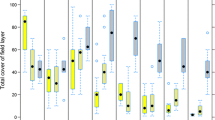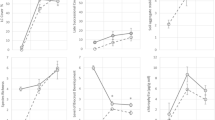Abstract
Capped waste sites often are vegetated with commercial turf grasses to increase evapotranspiration and prevent erosion and possible exposure of the barrier. Fertilizer, frequent watering, and mowing may be required to establish the turf grass and prevent invasion by trees and shrubs. Oldfield vegetation of grasses and forbs is a possible sustainable alternative to turf grass communities. To determine if oldfield vegetation can establish on caps, we (1) compared establishment of a dominant oldfield grass and a commercial turf grass under different combinations of new closure cap management: spring or summer planting and presence or absence of amendments to alleviate drought (watering, mulch) or increase soil fertility (fertilizer, lime, a nitrogen-fixing legume); (2) surveyed existing caps to determine if oldfield species establish naturally; and (3) performed a greenhouse experiment to compare growth of two native grasses under low and amended (added water, soil nutrients) conditions. Both the commercial grass and oldfield species established under new cap conditions; fertilizer, water, and mulch improved vegetation establishment in spring or summer, but legumes decreased grass cover. In the greenhouse, both native grasses grew best with amendments; however, substantial stem and root length were obtained with no fertilizer and only once-weekly watering. Existing vegetated caps supported planted grasses and naturally established oldfield species. Overall, the results indicate native grasses can establish on new caps and oldfields can serve as a management model; further work is needed to determine the management strategy to maintain herbaceous vegetation and slow woody species invasion.


Similar content being viewed by others
References
Berkowitz AR, Canham CD, Kelly VR (1995) Competition vs. facilitation of tree seedling growth and survival in early successional communities. Ecology 76:1156–1168
Castro J, Zamora R, Hódar J (2002) Mechanisms blocking Pinus sylvestris colonization of Mediterranean mountain meadows. Journal of Vegetation Science 13:725–731
Collins BS, Quinn JA (1982) Displacement of Andropogon scoparius on the New Jersey Piedmont by the successional shrub Myrica pensylvanica. American Journal of Botany 69:680–689
Collins BS, Wein GR (1990) Water relations and growth of Heterotheca subaxillaris in different soil and watering treatments in the greenhouse. Environmental and Experimental Botany 30:67–73
Collins BS, Pinder JE III (1990) Spatial distribution of forbs and grasses in a South Carolina oldfield. Journal of Ecology 78:66–76
Collins BS, Wein GR (1997) Mass allocation and self-burial of Aristida tuberculosa florets. Journal of the Torrey Botanical Society 124:306–311
Collins B, Wein G (1998) Soil resource heterogeneity effects on early succession. Oikos 82:238–245
Davis MA, Wrage KJ, Reich PB (1998) Competition between tree seedlings and herbaceous vegetation: support for a theory of resource supply and demand. Journal of Ecology 86:652–661
DeBlois S, Brisson J, Bouchard A (2004) Herbaceous covers to control tree invasion in rights-of-way: ecological concepts and applications. Environmental Management 33:606–619
Environmental Protection Agency (2003) Evapotranspiration landfill cover systems fact sheet. EPA 542-F-03-015
Golley FB (1965) Structure and function of an old-field broomsedge community. Ecological Monographs 35:113–137
Golley FB, Gentry JB (1966) A comparison of variety and standing crop of vegetation on a one-year and a twelve-year abandoned field. Oikos 15:185–199
Golley FB, Pinder JE III, Smallidge PJ, Lambert NJ (1994) Limited invasion and reproduction of loblolly pines in a large South Carolina old field. Oikos 69:21–27
Inouye RS, Allison TD, Johnson NC (1994) Old field succession on a Minnesota sand plain–effects of deer and other factors on invasion by trees. Bulletin of the Torrey Botanical Club 121:266–276
Martin PJ, Stephens W (2006) Willow growth in response to nutrients and moisture on a clay landfill cap soil. I. Growth and biomass production. Bioresource Technology 97:437–448
Pinder JE III, Golley FB, Lide RF (1995) Factors affecting limited reproduction by loblolly pine in a large old field. Bulletin of the Torrey Botanical Club 122:306–311
Robinson GR, Handel SN (1995) Woody plants fail to penetrate a clay-lined landfill: management implications. Environmental Management 19:57–64
Workman SW, McLeod KW (1990) Vegetation of the Savannah River Site: major community types. SRS National Environmental Research Park Program SRO-NERP-19
Acknowledgments
Primary funding for this research was provided by a grant from Westinghouse Savannah River Company to B. Collins and K. McLeod. Other support was provided by Financial Assistance Award Number DE-FC09-96SR 18456 from the U.S. Department of Energy to the University of Georgia Research Foundation. We would like to thank C. Crawford, S. Crawford, and A. Doss for their assistance in the field, B. Moyer and G. Wein for assistance with the greenhouse experiment, M. Redd and G. Counts for logistical support, and two anonymous reviewers.
Author information
Authors and Affiliations
Corresponding author
Rights and permissions
About this article
Cite this article
Kwit, C., Collins, B. Native Grasses as a Management Alternative on Vegetated Closure Caps. Environmental Management 41, 929–936 (2008). https://doi.org/10.1007/s00267-008-9090-x
Published:
Issue Date:
DOI: https://doi.org/10.1007/s00267-008-9090-x




